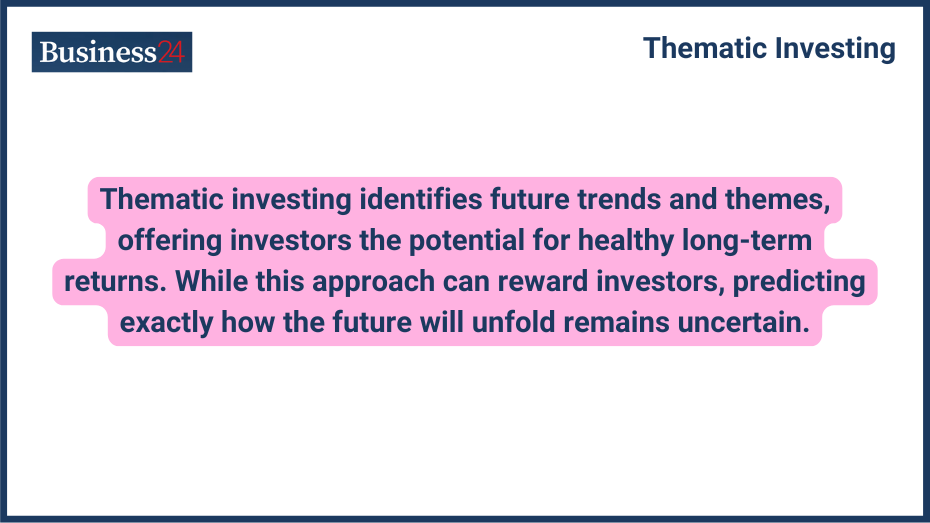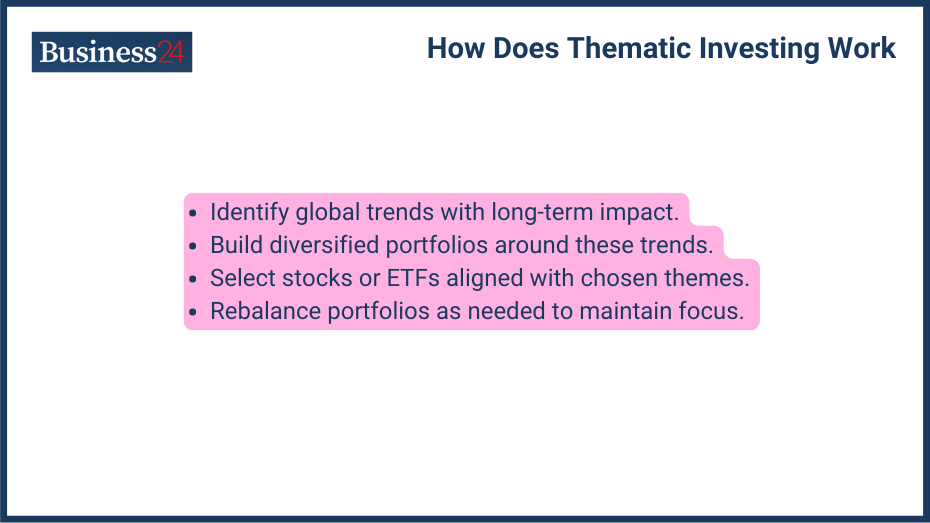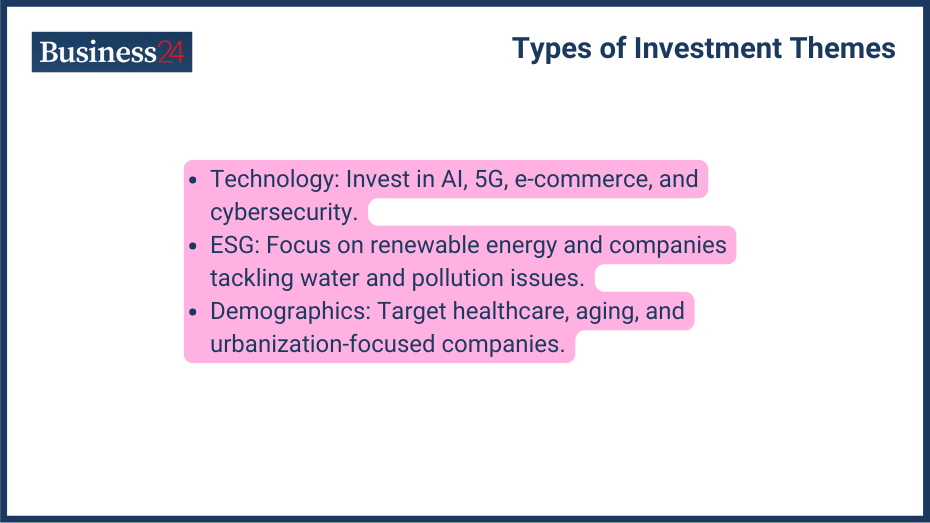
Thematic investing identifies future trends and themes, offering investors the potential for healthy long-term returns. While this approach can reward investors, predicting exactly how the future will unfold remains uncertain.
Sometimes, some sectors receive more economic benefits due to several factors, such as economic policies, the nature of business, etc. These advantages in particular sectors help generate higher returns for companies. Investing in these sectors or themes is known as thematic investing.
Or we can say thematic investing is a strategy focusing on investing in companies or sectors aligned with specific, long-term economic, social, or technological trends. Instead of relying solely on traditional stock picking or market indices, thematic investors seek to capitalize on the growth potential of industries or companies that drive or benefit from significant global shifts.
The Rise of Thematic Investing in Modern Markets
Thematic investing has gained significant popularity in recent years due to several factors:
- Rapid technological advancements: The rise of digital technologies, artificial intelligence, and automation has created new investment opportunities and disrupted traditional industries.
- Demographic shifts: Demographic shifts are profoundly impacting the global economy, and thematic investing can help investors identify investment opportunities that align with these trends.
- Increased complexity of global markets: The interconnectedness of global economies and the increasing complexity of financial markets have made it challenging for investors to identify and capitalize on traditional growth opportunities.
How Thematic Investing Works?

Identifying Global Trends
The first step in thematic investing is to identify global trends that are likely to have a significant and long-lasting impact on the economy and society:
- Analyzing macroeconomic factors: Understanding broader economic trends, such as GDP growth, interest rates, and inflation, can help identify potential investment themes. Macroeconomic factors provide a wider context for understanding global trends and can help investors identify investment opportunities aligned with long-term economic growth.
- Monitoring technological advancements: Staying current with technological developments can reveal emerging sectors and companies poised to benefit from these trends. Technological advancements drive significant changes in various industries, and investors can identify investment opportunities by staying up-to-date on the latest developments.
Building Portfolios Based on Investment Themes
Once global trends have been identified, investors can build portfolios focused on specific themes. This involves:
- Selecting stocks and ETFs: Investors can choose individual stocks or exchange-traded funds (ETFs) exposed to the selected themes. Selecting the right stocks or ETFs is crucial for building a successful thematic portfolio.
- Diversification: To manage risk, investors can diversify their portfolios across multiple companies and sectors within a given theme. Diversification is essential for thematic investing.
- Rebalancing: As market conditions change, investors may need to rebalance their portfolios to maintain their desired exposure to the chosen themes. Rebalancing ensures that a thematic portfolio aligns with the investor’s original investment thesis.
Types of Investment Themes

There are various types of investment themes; the most common and new-age themes are:
- Technology and Innovation: Various technological developments are being used in various industries. Artificial intelligence is one of the most transformative technologies of our time, and it can potentially revolutionize a wide range of industries. Investors can identify investment opportunities by focusing on companies developing and utilizing AI technologies innovatively.
Investing in companies involved in the development and deployment of 5G infrastructure. 5G networks are the next generation of wireless technology, and they can potentially transform industries such as telecommunications, healthcare, and manufacturing. Other technological developments like e-commerce cybersecurity are also important and can be a thematic investment. - Environmental, Social, and Governance (ESG): Renewable energy is a growing sector of the economy, driven by the increasing demand for clean and sustainable energy sources. Other ideas include investing in companies that promote sustainable farming practices and reduce their environmental impact. One emerging sector is companies that provide solutions to water scarcity and pollution. These are growing global challenges, and investors can identify investment opportunities by focusing on companies that solve these problems.
- Demographics and Social Change: You can also invest in various companies that are doing good in society. Some ideas include healthcare, retirement services, and consumer products catering to the needs of an aging population.
Also, you can look for companies in infrastructure, real estate, and consumer goods that are related to urbanization trends. Urbanization is a global trend, creating a growing demand for infrastructure, real estate, and consumer goods related to urban living.
Advantages of Thematic Investing
The advantages of thematic investing are:
- Long-Term Growth Potential: Thematic investing focuses on long-term trends and can provide exposure to industries with significant growth potential. By investing in companies that are driving or benefiting from these trends, investors can potentially achieve higher returns over the long term.
- Tailored Exposure to Emerging Trends: With Thematic investing, investors can tailor their portfolios to specific trends that align with their investment goals and risk tolerance. This can provide a more targeted and focused approach to investing compared to traditional broad-based strategies.
- Flexible Approach: Thematic investing offers a flexible approach that allows investors to tailor their portfolios to specific trends that align with their investment goals and risk tolerance. This can provide a more focused and targeted approach to investing compared to traditional broad-based strategies.
Risks and Considerations
The risk associated with thematic investing:
- Sector-Specific Risks: Thematic investing can be subject to sector-specific risks, meaning that a particular industry or sector’s performance can heavily influence a portfolio’s performance. If a specific industry experiences a downturn, it can negatively impact the overall performance of a thematic portfolio.
- Volatility and Over-concentration: This type of investing can be more volatile than traditional investing strategies, as it often involves investing in smaller companies or emerging sectors subject to greater price fluctuations. Additionally, over-concentration in a single theme can increase risk, as a downturn in that sector can significantly impact the overall portfolio.
How to Get Started with Thematic Investing
The first step in thematic investing is identifying themes aligning with your investment goals and risk tolerance. Check your long-term financial objectives, knowledge of different sectors, and comfort level with risk:
- Long-term financial objectives: Your long-term financial goals, such as retirement savings, education funding, or wealth-building, are crucial while creating an investment plan. This will help you identify themes likely to provide the returns you need to achieve your goals.
- Knowledge of different sectors: To put your money in a specific sector, you need knowledge of different sectors and industries. If you have expertise in a particular area, you should focus on themes related to that sector.
- Comfort level with risk: Some themes may be more volatile than others, so choosing themes that align with your comfort level with risk is important.
Conclusion
Thematic investing offers a unique approach that focuses on long-term trends and provides exposure to emerging industries. By carefully selecting themes and managing risks, investors can potentially achieve higher returns and align their investments with their values and goals. As global markets continue to evolve, thematic investing will likely play an increasingly important role in the investment landscape.
FAQ
What is an example of thematic investment?
An example of thematic investment is focusing on renewable energy, where investors target companies involved in solar, wind, or other sustainable energy solutions. This aligns with the growing global trend toward environmental sustainability.
What is a thematic strategy?
A thematic strategy involves investing in specific trends or themes expected to shape the future economy or society, such as technological innovation, climate change solutions, or demographic shifts.
Why is thematic investing important?
Thematic investing is important because it allows investors to capitalize on long-term trends that can lead to significant growth opportunities, aligning portfolios with future economic and societal developments.
How to do thematic investing?
To do thematic investing, identify a long-term trend (e.g., AI or ESG), research companies or ETFs that align with this theme, build a diversified portfolio, and regularly rebalance to maintain exposure to the chosen theme.
Disclaimer
eToro is a multi-asset platform which offers both investing in stocks and cryptoassets, as well as trading CFDs.
Please note that CFDs are complex instruments and come with a high risk of losing money rapidly due to leverage. 51% of retail investor accounts lose money when trading CFDs with this provider. You should consider whether you understand how CFDs work, and whether you can afford to take the high risk of losing your money
This communication is intended for information and educational purposes only and should not be considered investment advice or investment recommendation. Past performance is not an indication of future results.
Copy Trading does not amount to investment advice. The value of your investments may go up or down. Your capital is at risk.
Don’t invest unless you’re prepared to lose all the money you invest. This is a high-risk investment and you should not expect to be protected if something goes wrong. Take 2 mins to learn more
eToro USA LLC does not offer CFDs and makes no representation and assumes no liability as to the accuracy or completeness of the content of this publication, which has been prepared by our partner utilizing publicly available non-entity specific information about eToro.
